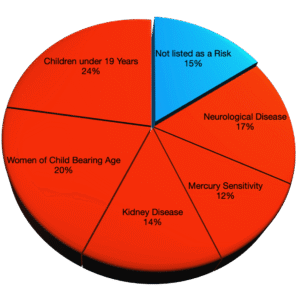According to FDA 2020 Guidelines

Based on FDA recommendations released in September 2020, over 85% of the US population is at risk for adverse reactions from mercury exposure created by dental amalgam fillings.1 If it is dangerous for this large of a segment of the population, why are we considering using them for anyone?
People with Neurological Diseases (17%): In a systematic analysis of the Global Burden of Disease (GBD) 2017 study published in JAMA, data on incidence, prevalence, mortality, and disability-adjusted life-years of major neurological disorders in the US were derived. Approximately 1 in 6 adults were estimated to have neurological disease. Fourteen major neurological disorders were analyzed including stroke, Alzheimer disease and other dementias, Parkinson disease, epilepsy, multiple sclerosis, motor neuron disease, migraine, tension-type headache, traumatic brain injury, spinal cord injuries, brain and other nervous system cancers, meningitis, encephalitis, and tetanus.2
Sensitivity/Allergy to Mercury (12%): This population includes individuals with documented hypersensitivity or allergy to mercury, which can manifest in various symptoms. Research indicates that sensitivity among the general population varies, with certain demographics, especially those with specific health conditions, exhibiting a higher risk upon mercury exposure.3,4
Kidney Disease (14%): Individuals with kidney disease are at a higher risk due to their compromised ability to excrete heavy metals like mercury. Studies have shown a significant correlation between dental amalgam exposure and elevated mercury levels in urine among children and adults with kidney impairment.5,6 The prevalence of kidney disease in the U.S. is around 14%.7
Women of Child-Bearing Age (20%): Women of child-bearing age, especially pregnant women, are particularly vulnerable to the effects of mercury. Research links amalgam exposure to adverse pregnancy outcomes, leading this population to be advised to limit mercury exposure to safeguard fetal development.8–16 One important issue to keep in mind is that the rate of unintended pregnancies is high and therefore occur in women who aren’t prepared or thinking about protections for themselves and their unborn children17,18. Given the current landscape wherein 12 states have a total abortion ban and 29 states have abortion bans based on gestational duration,19,20 more children will be born to younger women and this will have greater effects in women with lower socio-demographic backgrounds.
Children (24%): Children represent a high-risk group for mercury toxicity due to their developing nervous systems.9,16,21 Studies have shown a direct relationship between the number of amalgam fillings in children and levels of mercury in their blood and urine.6 The prevalence of amalgam restorations in permanent teeth ranged from 4.1% among those aged 6 through 11 years to 15.3% among those aged 12 through 15 years and 22.8% among those aged 16 through 19 years.22
Overlap between one or more of these conditions would add significant burden to anyone who belongs to one of the categories listed. For example, individuals suffering from neurological diseases may exhibit increased sensitivity due to their conditions. Children with kidney disease are particularly vulnerable to heavy metal toxicity due to mercury in dental fillings. Women who are pregnant or breastfeeding who also have another one of the FDA-identified risks would have compounded risk. There may also be an intersecting category of individuals with all risk factors: children with neurological diseases, who are sensitive to mercury and have kidney issues, potentially more common in low-income backgrounds where amalgam dental fillings are used almost exclusively.


